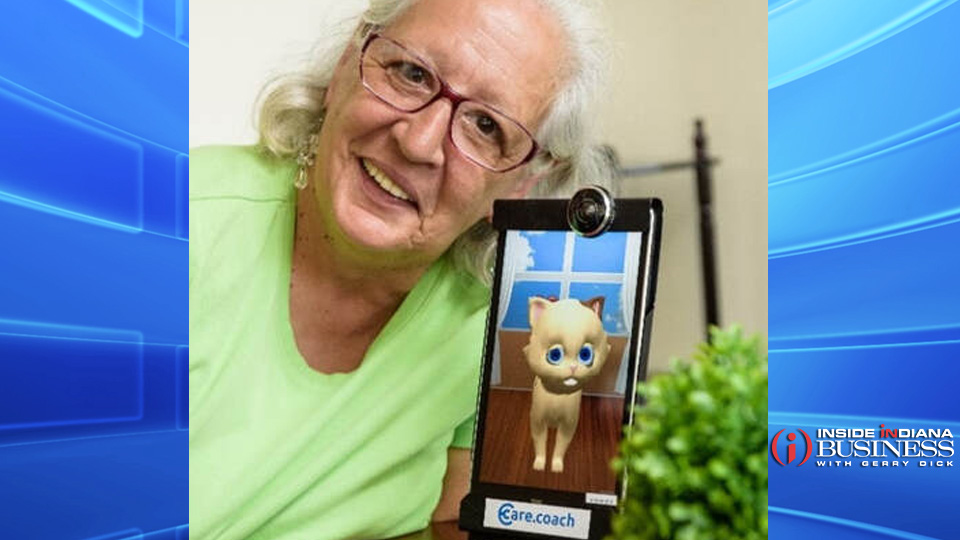IUSM studies virtual pets to sniff out dementia care solution
Subscriber Benefit
As a subscriber you can listen to articles at work, in the car, or while you work out. Subscribe Now
INDIANAPOLIS - Some 200 Hoosiers with Alzheimer’s disease and related dementia are befriending virtual pets on tablets to see if the daily interactions not only help reduce some of the symptoms of the illness, but also ease caregivers’ stress. Improving both factors could ultimately mean patients remain living at home instead of an institution setting. Richard M. Fairbanks Professor of Aging Research Dr. Malaz Boustani says, although the Indiana University School of Medicine “is the best in the world” at developing care models for patients with dementia, the school’s earlier solutions haven’t been scalable, because they all required clinicians. The results of this study could determine if the answer lies in animated cats and dogs.
The talking cats and dogs work on a specialized tablet and are designed to help the person with dementia accomplish daily tasks; the pet can remind them to take medication, help them make a phone call or play music. Daily interactions with the pet, such as having conversations, complimenting the person with dementia, or encouraging them with tasks helps build a relationship with the user.
“I was very skeptical. I was like, ‘Oh, come on.’ But some of my patients enrolled in our study come [in to my clinic] and say, ‘I talked with Tony.’ I would say, ‘Who’s Tony?’ And they’d say, ‘My dog!’” says Boustani. “It was big time surprising for me—that level of engagement. That’s my favorite feature.”
The virtual pet is the creation of San Francisco-based company care.coach, and the much of the pet’s actions are controlled by a live care.coach worker. The worker types responses from a remote location, and the words are delivered in the pet’s voice. For example, when the virtual dog goes to sleep, the user can wake it up by petting him—prompting the trained care.coach worker on the other end to begin interacting with the user again, or even call his or her name if the user is out of view.
Boustani says data already shows that care.coach helps reduce social isolation—a significant challenge for people with Alzheimer’s and dementia—so IUSM is charged with evaluating the technology even further. The study will see if the pets help prevent the behavioral and psychological symptoms in people with Alzheimer’s, and as a result, reduce or prevent stress among family caregivers. These symptoms include irritability, agitation, wandering, feelings of anxiety or depression and sleeping disturbances.
“Sometimes these symptoms can be triggered by social isolation, so we’re trying to overcome the social isolation to reduce the behavioral and psychological symptoms. All of these symptoms are a major driving force for caregivers’ stress,” says Boustani. “If the symptoms go down, then caregivers’ stress goes down, and people can maintain living at home longer and not have to go to an institution setting. That’s the chain of logic.”
Boustani says IUSM chose the care.coach technology because “it’s all about scalability”—a critical need as the U.S. population ages and the number of people with Alzheimer’s and dementia outpace caregivers.
“The first version of [IUSM’s] care model required a physician, the second one required a nurse practitioner, the third, a couple of nurses and social worker, and the last one we tried was community health workers—but they’re all only available [during normal office hours], not after hours or on the weekends,” says Boustani. “So despite everything we’ve done with our care model, we haven’t scaled it that much. That’s why we’re going to an internet-based solution that’s available 24/7. It appealed to my scalability obsession.”
Boustani says the biggest challenge in the study is convincing caregivers that it will take time for their loved one to build a relationship with the pet.
“The caregiver, in the beginning, has a high level and immediate level of expectation, and they give up on the pet very quickly,” says Boustani. “I always tell them you don’t give up on a pet in the first couple of months; you…spend a lot of time training the pet to be a friend. So don’t give up on these pets right away; it will get you a huge return on investment.”
It’s time that could translate into their loved one remaining home longer.
“This digital therapeutic solution is something I could even offer my father in Syria. He has the internet, and we can buy a tablet and eventually provide this to him,” says Boustani. “That’s the reason for my obsession with scalability. Even in countries ripped apart by war, it could be a scalable solution.”
Boustani says the use of pets is very intentional, because users show greater interaction with animal avatars compared to human ones.
Boustani explains why IUSM chose to evaluate the virtual pet technology in particular.
